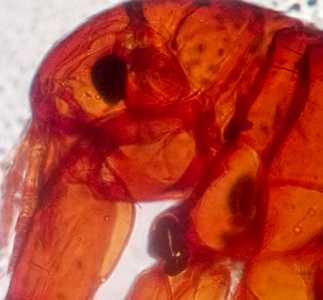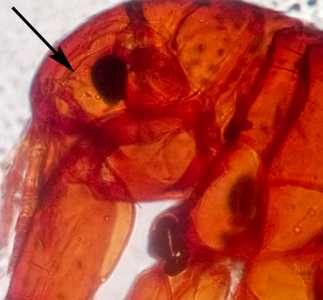
Case #391 - March 2015
A lab in India received an arthropod specimen from a parent whose child had been suffering for about a week with rashes over his extremities and back. The patient was initially treated for the rashes, but they returned. Images of the organism were captured and sent to the DPDx Team for diagnostic assistance. Figures A and B show two of the images received. What is your identification? Based on what criteria? What is the public health importance, if any, of this organism?

Figure A

Figure B
Case Answer
The arthropod in this case was the human flea, Pulex irritans. Diagnostic morphologic features included:
- a lack of both pronotal and genal combs.
- mesopleuron not divided by a sclerotized rod.
- ocular bristle (arrow, Figure B) located below the top of the eye.
Pulex irritans is primarily a nuisance pest. It is not an efficient vector of disease-causing agents but can serve as an intermediate host for the intestinal cestodes Dipylidium caninum, Hymenolepis nana, and H. diminuta.

Figure B
More on: fleas
This case and images were kindly provided by Drs. Prakash Ramakrishna and Lokanatha Keshavalu, Bangalore, India.
Images presented in the monthly case studies are from specimens submitted for diagnosis or archiving. On rare occasions, clinical histories given may be partly fictitious.
DPDx is an education resource designed for health professionals and laboratory scientists. For an overview including prevention and control visit www.cdc.gov/parasites/.
- Page last reviewed: August 24, 2016
- Page last updated: August 24, 2016
- Content source:
- Global Health – Division of Parasitic Diseases and Malaria
- Notice: Linking to a non-federal site does not constitute an endorsement by HHS, CDC or any of its employees of the sponsors or the information and products presented on the site.
- Maintained By:


 ShareCompartir
ShareCompartir